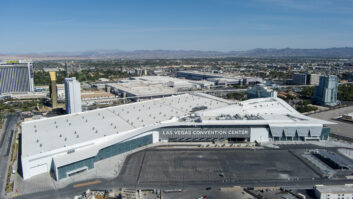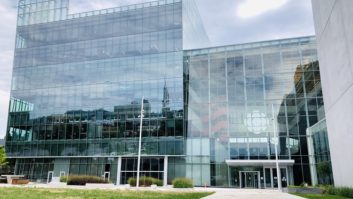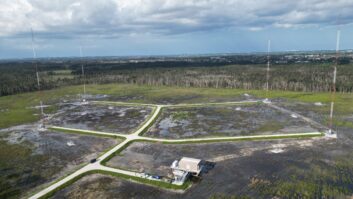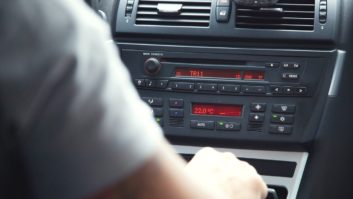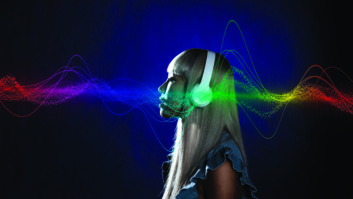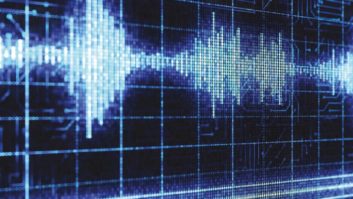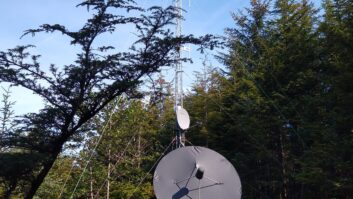The call sign for WBCQ is corrected below; it was given as WCBQ in an earlier version.
DAYTON, Ohio — Imagine the NAB Show scaled to three days and fitted into a 16,000-square-foot venue that can accommodate a normal crowd of perhaps 7,000.

Gerry Moersdorf’s philosophy is ‘Never operate any transmitter that can’t kill you if it falls over!’ This creation is a commercial Collins 20V-3 AM broadcast transmitter modified to operate on the ham bands in a mobile configuration. It’s powered by a generator; a special frame allows him to lift the 1,000-plus pound transmitter quickly on and off the pickup truck.
Imagine also a show where the parking lot, instead of hosting a couple dozen remote trucks, is the scene of fast-paced wheeling and dealing, with 2,000 or so venders waiting to sell you anything from the latest test gear to a vacuum tube for a 1920s radio receiver.
If you’ve been to the Dayton Hamvention, you don’t have to imagine. You’ve lived it.
In recent years this annual event has drawn 20,000 or more radio aficionados (more than a few of whom work in broadcast engineering) to a town of 141,000. It is the place to be if you’re really serious about amateur radio; and the parking lots are full of cars with amateur radio call signs from virtually every state in the union.
“Dayton” traces its roots back nearly 60 years to 1952 and the efforts a small group of amateur radio operators working with $100 in seed money. That ham convention has steadily grown to become today’s three-day premier event in ham circles.
An international calling
So what exactly is “Dayton?”
In addition to the obvious convention aspects, with wall-to-wall presentations and a lot of socializing, it’s a gigantic flea market that features electronic gear of every description, and a very respectable trade show, where manufacturers of amateur radio and allied equipment get the chance to display their latest wares and (hopefully) create a market for these new products.

The outdoor flea market is a big draw. Some 2,000 tailgating/table spaces are available and most are occupied during the show.
This year’s Hamvention, held in May, was themed “Global Friendship,” a phrase that typifies the spirit of amateur radio. Radio waves know no international boundaries. Ham operators revel in the number of wireless contacts they are able to make with like-spirited individuals, sometimes operating from some of the remotest locations on earth (or even from space). And during emergency situations, amateur radio can be the only communications link to the outside world.
“It seems as if world events continue to bring forth both major political and geographical upheavals affecting millions of people throughout the world,” said Michael Kalter, general chairman of this year’s Hamvention.
“Amateur radio could not be more relevant or needed than at the present moment. At the heart of these political uprisings and natural disasters are the amateur radio operators who tirelessly hold open the communication lifeline to the outside world. I heard news accounts that during the crisis in the Middle East the Internet was shut down for periods and the only communication available was through amateur radio.”
Kalter remarked that ham radio has been responsible for promoting friendships on a global basis and that it provides one of the best opportunities for doing so.

On the main show floor, this massive ‘portable’ 145-foot crank-up tower from Luso drew a lot of attention. It lists for $40,000, though the ‘show special’ was $36,000.
As part of the Global Friendship initiative, this year’s event featured booths with representatives from amateur radio organizations in Great Britain, Germany, Japan, China and Qatar on hand to greet attendees and field questions about amateur radio activities in their respective countries.
A special guest, astronaut Doug Wheelock, was on hand to greet show attendees. Wheelock is a licensed radio amateur and spent part of his time aboard the International Space Station making radio contacts with earthbound hams, including groups of young people at school and camp ham stations.
The unusual is common here
Just as at NAB, crowds start to gather early outside the main entrance to the exhibit hall — in this case, Dayton’s Hara Arena — and at the appointed time pour into every nook and cranny of the building to check out the latest gadgets from the commercial venders and to station themselves at the locations of radio-related presentations and forums.
However, many stream right on through the building and out onto its parking lot for some of the most unusual sights and sounds of the show.
This is the location of truly one-of-a-kind items, be they a collection of “QSL” cards (a mailed transmission confirmation report) from the 1930s, military communications equipment or even some high-end audio gear. The 2,500 stall-space flea market area is a showplace for hams wanting to display something special that they’ve created.
Crowds this year weren’t disappointed. A big draw was a Collins 20V-3, a 1 kW transmitter that had pressed into amateur radio service after many years of duty at an AM broadcast station. It’s now owned by Gerry Moersdorf (amateur station call sign KC8ZUL) and holds the title of “the world’s first mobile AM broadcast rig.”
The vintage broadcast transmitter was modified extensively to allow frequency-agile operation within the HF ham band assignments and to be controlled from the confines of Moersdorf’s pickup truck cab. The 1,300 pound transmitter rides in the bed of the truck on a special mount that allows it to be installed or removed quickly.

Ted Randall, a familiar voice to listeners of the 50,000 Watt U.S. shortwave station WBCQ, brought his ‘QSO Radio Show’ to Dayton and broadcast live from the Hamvention exhibits hall.
Moersdorf erected a 40 meter dipole near his truck for the occasion and was inviting licensed hams to give the unique rig a try on 3.885 MHz.
He has a large collection of broadcast transmitters and a rather unique philosophy to describe his affinity for “big iron” (the nickname for commercial transmitters within the ham community), “Never operate any transmitter that can’t kill you if it falls over!”
When he’s not collecting and modifying Gates, Collins and RCA tube transmitters, Moersdorf is president of Audio Power Labs in Columbus, Ohio. In addition to the mobile 20V-3, he offered another attraction for visiting hams, a sample of company’s top-of-the line audio amp, the 833TNT.
Demos were staged in the trailer section of an 18-wheeler (which also contained the carcass of a Gates broadcast rig destined for restoration and hamming). The massive tube-type audio amps are based around a pair of 833C transmitter-type graphite anode triodes and crank out an honest 200 Watts RMS with a distortion of less than 1 percent. They weigh in at 160 pounds each (you’ll need two for stereo) and come with a price tag of $175k for the pair.
Inside Hara Arena, the scene was booth-after-booth-after-booth — somewhat reminiscent of the NAB Show. According to Henry Ruminski, one of the show’s volunteer organizers, floor space this year was at the “sell-out” level, with some 250 commercial exhibitors showing off wares.
One of the largest exhibitors space-wise was the ARRL (American Radio Relay League), the non-profit organization that represents the interests of ham radio operators.

While not exactly the Las Vegas Convention Center, the Dayton Hara Arena is up to the task of hosting the annual Hamvention. (And this convention hall’s hot dogs are only $3.)
“We estimate that there are some 600,000 to 625,000 amateur radio operators in the United States,” said Harold Kramer, the group’s COO. “And 157,000 of them are ARRL members.”
Remotes to the world
Another “indoor” attraction was Ted Randall, host of the QSO Radio Show on WBCQ, a 50,000 Watt international broadcast station based in Monticello, Maine.
Randall was set up in a broadcast booth environment and did live broadcasts during the run of the show. And despite the deemphasis in recent years on shortwave broadcasting by such entities as the BBC and VOA, Randall is upbeat about its potential.
“It’s really surprising,” he said. “When I play music, I sometimes get 300 or more e-mails an hour. That’s something that even the big clear channel AMs can’t claim anymore.”
The staging of the Dayton Hamvention is an all-volunteer effort, with some 750 to 800 persons volunteering their time each year to make the event run smoothly. Next year’s show is set for May 18–20.
James O’Neal is technology editor of TV Technology and a frequent contributor to Radio World.





